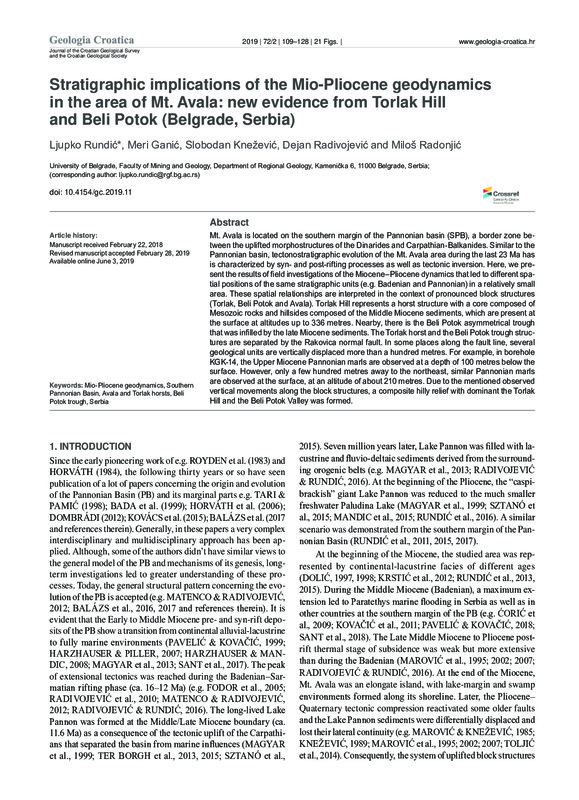Stratigraphic implications of the Mio-Pliocene geodynamics in the area of Mt. Avala: new evidence from Torlak Hill and Beli Potok (Belgrade, Serbia)
Објеката
- Тип
- Рад у часопису
- Верзија рада
- објављена верзија
- Језик
- енглески
- Креатор
- Ljupko Rundić, Meri Ganić, Slobodan Knežević, Dejan Radivojević, Miloš Radonjić
- Извор
- Geologia Croatica
- Датум издавања
- 2019
- Сажетак
-
Mt. Avala is located on the southern margin of the Pannonian basin (SPB), a border zone between the uplifted morphostructures of the Dinarides and Carpathian-Balkanides. Similar to the Pannonian basin, tectonostratigraphic evolution of the Mt. Avala area during the last 23 Ma has is characterized by syn- and post-rifting processes as well as tectonic inversion. Here, we present the results of field investigations of the Miocene‒Pliocene dynamics that led to different spatial positions of the same stratigraphic units (e.g. Badenian and Pannonian) in a relatively small area. These spatial relationships are interpreted in the context of pronounced block structures (Torlak, Beli Potok and Avala). Torlak Hill represents a horst structure with a core composed of Mesozoic rocks and hillsides composed of the Middle Miocene sediments, which are present at the surface at altitudes up to 336 metres. Nearby, there is the Beli Potok asymmetrical trough that was infilled by the late Miocene sediments. The Torlak horst and the Beli Potok trough structures are separated by the Rakovica normal fault. In some places along the fault line, several geological units are vertically displaced more than a hundred metres. For example, in borehole KGK-14, the Upper Miocene Pannonian marls are observed at a depth of 100 metres below the
surface. However, only a few hundred metres away to the northeast, similar Pannonian marls are observed at the surface, at an altitude of about 210 metres. Due to the mentioned observed vertical movements along the block structures, a composite hilly relief with dominant the Torlak Hill and the Beli Potok Valley was formed. - том
- 2
- Број
- 72
- почетак странице
- 109
- крај странице
- 128
- doi
- 10.4154/gc.2019.11
- issn
- 1330-030X
- Просторно покривање
- Србија
- Subject
- мио-плиоценска геодинамика, јужни Панонски басен, Авалски и Торлак хорст, Белопоточки трог, Србија
- Mio-Pliocene geodynamics, Southern Pannonian Basin, Avala and Torlak horsts, Beli Potok trough, Serbia
- Шира категорија рада
- M20
- Ужа категорија рада
- М22
- Права
- Отворени приступ
- Лиценца
- Creative Commons – Attribution 4.0 International
- Формат
- Скупови објеката
- Љупко Рундић
- Мери Ганић
- Слободан Кнежевић
- Милош Радоњић
- Дејан Радивојевић
- Radovi istraživača
Ljupko Rundić, Meri Ganić, Slobodan Knežević, Dejan Radivojević, Miloš Radonjić. "Stratigraphic implications of the Mio-Pliocene geodynamics in the area of Mt. Avala: new evidence from Torlak Hill and Beli Potok (Belgrade, Serbia)" in Geologia Croatica (2019). https://doi.org/10.4154/gc.2019.11
This item was submitted on 27. новембар 2021. by [anonymous user] using the form “Рад у часопису” on the site “Радови”: http://dr.rgf.bg.ac.rs/s/repo
Click here to view the collected data.
